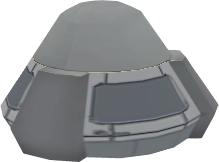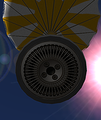Difference between revisions of "Mk16 Parachute"
m (fixed a bad link from my previous edit) |
Insert name (talk | contribs) m (→Pressure) |
||
| Line 22: | Line 22: | ||
==== Pressure ==== | ==== Pressure ==== | ||
| − | The default .04 partial deployment pressure corresponds to an altitude of around 17000 meters on Kerbin. At that altitude a parachute will have almost no effect, and your craft will probably continue to accelerate down to an altitude of 10000 meters - usually destroying your parachute. So keeping this default value is only useful if you intend to manually deploy your parachute at a particular moment. | + | The default .04 partial deployment pressure corresponds to an altitude of around 17000 meters on [[Kerbin]]. At that altitude a parachute will have almost no effect, and your craft will probably continue to accelerate down to an altitude of 10000 meters - usually destroying your parachute. So keeping this default value is only useful if you intend to manually deploy your parachute at a particular moment. |
A pressure value of .2 to .25 will partially deploy a parachute at about 8000 meters on Kerbin. This is a nice value because it is safely above the top of the highest mountains, but the atmosphere usually has enough time to slow your craft to a safe speed. If you think you need a little more time for atmospheric braking and you are willing to risk crashing on a mountaintop with unopened parachutes, you can set the value a little higher. | A pressure value of .2 to .25 will partially deploy a parachute at about 8000 meters on Kerbin. This is a nice value because it is safely above the top of the highest mountains, but the atmosphere usually has enough time to slow your craft to a safe speed. If you think you need a little more time for atmospheric braking and you are willing to risk crashing on a mountaintop with unopened parachutes, you can set the value a little higher. | ||
Revision as of 16:48, 21 April 2016
| Mk16 Parachute | ||
| Parachute by Found lying by the side of the road | ||
| Radial size | Tiny, Radial mounted | |
| Cost | (total) | 422.00 |
| Mass | (total) | 0.100 t |
| Drag | 0.1 | |
| Max. Temp. | 2500 K | |
| Impact Tolerance | 12 m/s | |
| Research | | |
| Unlock cost | 0 | |
| Since version | 0.7.3 | |
| Part configuration | parachuteMk1.cfg | |
| Semi-Deployed Drag | 1 | |
| Semi Deploy Min Pressure | 0.04 atm | |
| Fully-Deployed Drag | 500 | |
| Full Deployment Altitude | 1000 m AGL | |
| Max. Temp. | 650 K | |
| Testing Environments | ||
| On the surface | No | |
| In the ocean | No | |
| On the launchpad | No | |
| In the atmosphere | Yes | |
| Sub-orbital | No | |
| In an orbit | No | |
| On an escape | No | |
| Docked | No | |
| Test by staging | Yes | |
| Manually testable | No | |
| Packed volume | 140 l | |
The Mk16 Parachute module is primarily used to slow the descent of command modules; like all parachutes it can be used to slow any part.
Contents
Usage
This parachute performs almost identically to an Mk2-R Radial-Mount Parachute, even though it looks a lot bigger when deployed.
All parachutes currently have four activation stages: unactivated, activated, partial deployment, and fully deployed. A parachute becomes activated when it is staged, or when the "deploy" button is clicked and the craft is in flight, or it is triggered through an action group -- the parachute's icon will turn green, but nothing else will happen at that point. Parachutes can be activated only on a craft that has some kind of command unit, so it is sometimes important to activate them before they get decoupled from the main craft.
A parachute will automatically go into partial deployment mode if it is activated and then descends below the atmospheric pressure set in its tweakable values. It will automatically go into full deployment if it is already partially deployed, and reaches an altitude above the terrain that is set in the tweakable values.
Right-clicking on the parachute (or looking at the parachute's icon) will give you information on whether the parachute is likely to survive being partially or fully deployed at the craft's current speed. On Kerbin, this parachute can always safely fully deploy at a speed of around 255 meters per second. Safe partial deployment speeds are slightly higher, and depend on atmospheric pressure.
Partial deployment provides a "drogue-like" effect that will hopefully keep your craft falling at a safe medium speed until the parachute fully deploys.
Usage Details
In the current version attempting to activate parachutes and a decoupler on the same stage seems to be dangerous. Sometimes the decoupler activates first and then the parachutes do not activate at all.
It is almost always useful to tweak the tweakable values on these parachutes.
Pressure
The default .04 partial deployment pressure corresponds to an altitude of around 17000 meters on Kerbin. At that altitude a parachute will have almost no effect, and your craft will probably continue to accelerate down to an altitude of 10000 meters - usually destroying your parachute. So keeping this default value is only useful if you intend to manually deploy your parachute at a particular moment.
A pressure value of .2 to .25 will partially deploy a parachute at about 8000 meters on Kerbin. This is a nice value because it is safely above the top of the highest mountains, but the atmosphere usually has enough time to slow your craft to a safe speed. If you think you need a little more time for atmospheric braking and you are willing to risk crashing on a mountaintop with unopened parachutes, you can set the value a little higher.
If you are certain that your craft will land at sea level (or at least below 1000 meters altitude), then you can set the pressure value all the way up to .75, which corresponds to an altitude of 2000 meters on Kerbin.
Altitude
The Mk16 parachute transitions from partial to full deployment very slowly. So your craft may easily fall another 600 meters while the parachute is opening, and it is almost always best to leave this value set at the default value of 1000 meters.
Product description
| “ | The Mk16 Parachute might be considered by some to be little more than a random stitching together of the surplus parts it is, in fact, made from. But the fact remains that the Mk16 has been widely accepted as a generally better alternative to being in freefall. | ” |
Gallery
Fully deployed parachute, attached to Mk1 Command Pod
Changes
- Cannot be placed radially anymore (Introduction of Mk2-R Radial-Mount Parachute.)
- (part rebalancing) Changed weight from 0.3 to 0.1, and fully deployed drag from 55 to 500.
- (undocumented) Parachutes can now be radially attached. (previously they could only be placed on nodes)
- Parts now have an ActivatesEvenIfDisconnected parameter on the cfg to allow them to be activated after jettisoning
- Fixed parachutes not deploying if not set to the last stage. (they can still deploy when jettisoned)
- Parachutes now have a 'useAGL' parameter. If that's enabled, it will deploy when it reaches deploy altitude from ground level
- (undocumented) Parachutes no longer deploy outside of the atmosphere
- Parachutes can now deploy automatically if jettisoned along with other parts (allowing for parts to be safely landed)
- Added some sound effects for the parachute opening
- Added cfg-definable parameter for parachute autodeployment delay
- Initial release
| ||||||||||||||||||||||||||||

